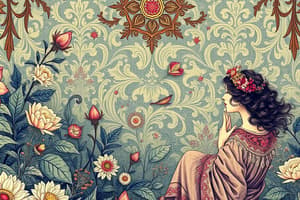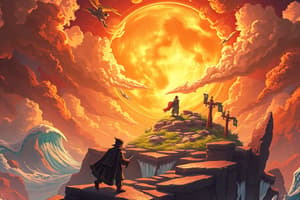Podcast
Questions and Answers
What does the Pakudos resemble?
What does the Pakudos resemble?
Indic swastika
What materials were traditionally used for the fabric of the Manobo clothing?
What materials were traditionally used for the fabric of the Manobo clothing?
Dyes for fabrics were obtained from the ______, tagum plant, and lamud tree.
Dyes for fabrics were obtained from the ______, tagum plant, and lamud tree.
turmeric root
What is the Sarimanok?
What is the Sarimanok?
Signup and view all the answers
What is the significance of the T’nalak cloth?
What is the significance of the T’nalak cloth?
Signup and view all the answers
Who are considered stage performers?
Who are considered stage performers?
Signup and view all the answers
The tight-fitting upper garment worn by Subanen men is called the ______.
The tight-fitting upper garment worn by Subanen men is called the ______.
Signup and view all the answers
Who is responsible for overseeing the technical aspects of a theater production?
Who is responsible for overseeing the technical aspects of a theater production?
Signup and view all the answers
What craft are the Tingguian people known for?
What craft are the Tingguian people known for?
Signup and view all the answers
Who is known as the Grand Dame of Southeast Asian children's theater?
Who is known as the Grand Dame of Southeast Asian children's theater?
Signup and view all the answers
Which of the following is a film by Kidlat Tahimik?
Which of the following is a film by Kidlat Tahimik?
Signup and view all the answers
Ryan Cayabyab is famous for his visual arts contributions.
Ryan Cayabyab is famous for his visual arts contributions.
Signup and view all the answers
Which type of line represents upward or downward movement?
Which type of line represents upward or downward movement?
Signup and view all the answers
What are the primary colors?
What are the primary colors?
Signup and view all the answers
The ______ is a type of stilt house indigenous to the cultures of the Philippines.
The ______ is a type of stilt house indigenous to the cultures of the Philippines.
Signup and view all the answers
Which statement is true about contour lines?
Which statement is true about contour lines?
Signup and view all the answers
What is the process of producing fabric by interlacing threads called?
What is the process of producing fabric by interlacing threads called?
Signup and view all the answers
Negative space refers to shapes and forms of art.
Negative space refers to shapes and forms of art.
Signup and view all the answers
Which of the following techniques is NOT used to create emphasis in art?
Which of the following techniques is NOT used to create emphasis in art?
Signup and view all the answers
What is the origin of the term 'art'?
What is the origin of the term 'art'?
Signup and view all the answers
Art is the expression of the creative skill and __________.
Art is the expression of the creative skill and __________.
Signup and view all the answers
Which of the following is NOT considered a basic element of art?
Which of the following is NOT considered a basic element of art?
Signup and view all the answers
What defines the value of color in art?
What defines the value of color in art?
Signup and view all the answers
Realism aims to depict subjects as they exist without interpretation.
Realism aims to depict subjects as they exist without interpretation.
Signup and view all the answers
Match the following art movements with their characteristics:
Match the following art movements with their characteristics:
Signup and view all the answers
In two-dimensional art, the distinguishing dimensions are __________ and __________.
In two-dimensional art, the distinguishing dimensions are __________ and __________.
Signup and view all the answers
What does the term 'non-representational art' refer to?
What does the term 'non-representational art' refer to?
Signup and view all the answers
Which of the following is NOT a function of art?
Which of the following is NOT a function of art?
Signup and view all the answers
List two sources of subjects in art.
List two sources of subjects in art.
Signup and view all the answers
What significant contribution does the Order of National Artists award recognize?
What significant contribution does the Order of National Artists award recognize?
Signup and view all the answers
What is a credit line in art?
What is a credit line in art?
Signup and view all the answers
The Insignia of the Order of National Artists includes a Grand Collar and a central medallion.
The Insignia of the Order of National Artists includes a Grand Collar and a central medallion.
Signup and view all the answers
What are the three philosophical themes in art?
What are the three philosophical themes in art?
Signup and view all the answers
In three-dimensional art, depth allows it to be viewed from __________ angles.
In three-dimensional art, depth allows it to be viewed from __________ angles.
Signup and view all the answers
Which of the following artists is known for their cartoons?
Which of the following artists is known for their cartoons?
Signup and view all the answers
Study Notes
Etymology and Definition of Art
- Art comes from the Latin term "ars," meaning skill, talent, or ability.
- It represents the expression of creative skill and imagination.
Elements of Art
- Line: One-dimensional path created by a point in space; varies in width, direction, and length.
- Shape: Defines objects with two dimensions (height and width); typically outlined by lines.
- Value: Indicates brightness or darkness of color; gradients show a range from dark to light.
- Form: Three-dimensional objects with height, width, and depth.
- Space: Indicates depth or three-dimensionality; involves area within the artwork.
- Texture: Surface quality perceived through touch; can be hard, soft, rough, smooth, etc.
- Color: Reflected light organized into a color wheel with primary, secondary, and intermediate colors.
History of Art Movements
- Naturalism: Realistic depiction of objects in natural settings; practiced in the Florentine school.
- Romanticism (1800): Reaction to industrialization; a revolt against political and social norms.
- Impressionism (1820): Focused on artistic freedom after scrutiny from critics.
- Realism (1850): Depicts subjects as they objectively exist; avoids interpretation.
- Symbolism (1860): Movement emphasizing symbolic meaning in art and poetry.
- Art Nouveau (1890): Transitional style between historicism and modernism, featuring natural forms.
- Expressionism: Art focused on emotional experience, reflecting symbolist influences.
- Cubism (1907): Art formed from geometrical shapes and interlocking planes.
- Dada (1916): Art questioning traditional meaning by using simple objects.
- Surrealism (1920s): Dream-inspired art depicting bizarre and mysterious images.
- Pop Art (1950): Based on modern popular culture and mass media.
Functions of Art
- Personal: Artists express themselves or communicate thoughts.
- Social: Addresses collective life aspects, relatable to viewers.
- Physical: Created for specific practical functions, such as tools or weapons.
Three Philosophical Themes in Art
- Integrity: Faithfulness to one's principles.
- Proportion/Consonance: Balance and consistency among elements.
- Radiance/Clarity: Impact and significance of art on viewers.
Subjects of Art
- Representational Art: Depicts reality as seen.
- Non-Representational Art: Departs from realistic representation.
Sources and Kinds of Subjects
- Nature, people and world events, myths, spiritual beliefs, commissioned ideas.
Form and Composition
-
Two-dimensional Art: Defined by width and height; limited to the frame.
- Drawings: Created using instruments on a surface.
- Paintings: Involves applying color using brushes or tools.
-
Three-dimensional Art: Contains depth, viewed from multiple angles.
- Includes sculpture, assembling, modeling, carving, casting, crafts, and architecture.
- Technological Media: Involves artworks created using new technologies like photography and computer graphics.
Content and Credit Line
- Includes artist's name, artwork title, year made, medium, size, and location.
Steps in Art Analysis
- Description: List questions to understand the artwork's elements.
- Analysis: Identify design principles applied and artist's individual style.
- Interpretation: Explore the artwork's message and its relevance.
- Judgment: Assess the success and significance of the artwork.
Artist vs. Artisan
- Artists create for emotional impact; artisans produce functional artistic products.
Related Careers in Arts
- Performing Arts: Actors, musicians, dancers, choreographers.
- Art and Creativity: Craft artists, multimedia artists, photographers.
- Skills Needed: Organization, marketing, public relations, flexibility.
R.A. 7355 (Manlilikha ng Bayan Act)
- Policy to preserve traditional folk arts and support artists.
- Qualifications include mastery of skills and willingness to teach.
Ad Hoc Panel of Experts
- A group of experts assists in selecting awardees for folk artists.
National Artists of the Philippines
- Recognizes significant contributions to arts and letters.
- Insignia consists of a Grand Collar and a medallion reflecting the Philippine flag.
Recent National Artists
- Lauro Alcala: Renowned cartoonist known for "Slice of Life."
- Amelia Lapeña-Bonifacio: Founder of children's theater in Southeast Asia.
- Ryan Cayabyab: Acclaimed composer and musical director.
- Kidlat Tahimik: Influential filmmaker known for "Mababangong Bangungot.”
- Francisco T. Mañosa: Architect celebrated for Filipino designs.
Types of Line
- Vertical: Movement up and down.
- Horizontal: Movement left to right.
- Diagonal: Slanted, creates rise or fall impression.
- Zigzag: Combination of diagonal lines.
- Curved: Lines with undefined direction.
Line and Value
- Value is the degree of darkness or lightness in the artwork.### Expressions of Lines
- Movement of Lines: Vertical lines symbolize permanence; horizontal lines convey strength; diagonal lines evoke instability, tension, or excitement; zigzag lines suggest confusion; curved lines represent activity.
- Contour Lines: Used to define edges or ridges, enhancing the perception of shapes and forms.
- Gesture Drawing: Captures expressive movements, emphasizing motion and emotion.
- Calligraphy Drawing: Art of beautiful handwriting, combining art and letterform.
Shape, Form, and Space
- Shape: Defined two-dimensional area, recognized by its outline.
-
Types of Shapes:
- Geometric shapes: Precisely measured with mathematical bases.
- Free-form shapes: Irregular, characterized by curves and angles.
- Form: Three-dimensional aspects of shapes, including depth.
-
Space Types:
- Positive space: Actual shapes and forms.
- Negative space: Empty or unoccupied areas surrounding shapes.
Illusion of Depth
- Gestalt Principles: Overlapping objects create depth; larger objects appear closer; lower placement of objects gives an impression of nearness; detailed objects seem nearer than those less detailed; bright colors suggest proximity; converging lines lead to a perception of distance.
Expressive Qualities of Shape, Form, and Space
- Free-form shapes: Convey life, fluidity, and comfort.
- Angular shapes: Depict sharp realities of the world.
- Geometric shapes: Represent mechanical order and logic.
Color Theory
- Primary Colors: Red, blue, yellow.
- Secondary Colors: Created by mixing two primary colors.
- Intermediate Colors: Formed by mixing a primary with a secondary color.
- Value: Indicates lightness or darkness of a color.
- Intensity: Measures the brightness or dullness of a hue.
Color Schemes
- Monochromatic Colors: Variations of one color (hue, tints, shades).
- Analogous Colors: Colors adjacent on the color wheel, promoting harmony.
- Complementary Colors: Strong contrasting color pairs.
- Color Triads: Three colors spaced evenly around the wheel.
- Split Complements: A color combined with two adjacent to its complement.
- Warm and Cool Colors: Warm colors include red, orange, yellow; cool colors include blue, green, violet.
Texture and Value
- Rough vs. Smooth Textures: Rough textures feature uneven shadows; smooth textures appear formally shaded.
- Matter vs. Shiny Textures: Matte surfaces reflect dull light; shiny surfaces glitter with reflected light.
Balance in Design
- Formal Balance: Equal distribution of elements on either side of symmetry.
- Radial Balance: Design radiating from a central point, like a mandala.
- Informal Balance: A relaxed, less structured approach to composition.
Principles of Design
- Proportion: Lines and elements create movement impressions; varies based on size.
- Emphasis: Highlights specific aspects through color intensity, contour definition, etc.
-
Emphasis Techniques:
- Contrast: Differences in hues, intensity, and value.
- Isolation: Separating a subject from other elements.
- Location: Central positioning as the focal point.
- Convergence: Elements directing attention toward a focal point.
- Unusual: Unique approaches for emphasis.
Abstract/Non-Objective Arts
- Created from unconventional images using shapes, colors, and gestural marks.
Installation Arts
- Three-dimensional works, often site-specific, altering perception of space.
- Includes various forms such as Body Installation and Land/Earth Installation.
Music in Art
- Recognized as the highest form of performing art.
- Functions include religious ceremonies, entertainment, socio-cultural events, and political campaigns.
Major Periods of Music Development
- Medieval Period: Introduction of Gregorian chant, polyphony, and rhythmic modes.
- Instruments: Include wind instruments, string instruments, and percussion.
Influential Figures of the Medieval Period
- Pope Gregory the Great: Established Gregorian chant.
- Guillaume de Machaut: Pioneered secular music.
- Hildegard of Bingen: Notable composer and herbalist.
Musical Genres in Medieval Period
- Religious music: Sacred themes like hymns.
- Gospel music: Praise and worship in Christian contexts.
Renaissance Musical Instruments
- Introduction of recorder, shawn, sackbut, lute, organ, and harpsichord.
Textile Art and Weaving
- Uses fibers from plants, animals, or synthetics to create practical or decorative objects.
- Fundamental cultural expression showcased through various techniques like crocheting, embroidery, knitting, and weaving.
Textile Production Process
- Includes fiber production, yarn production, fabric production, pre-treatment, dyeing, printing, finishing, and manufacturing.
Philippine Traditional Motifs and Crafts
- Diverse traditional houses and textile arts representing rich cultural heritage, such as the Torogan, Ifugao Bale, and Bahay Kubo.
Philippine Indigenous Arts
- Distinct weaving styles and materials, including ikat textiles, pandanus cloth, and traditional garments that reflect the unique identities of various tribes.
Stage Performing Arts
- Encompasses roles such as antagonists, protagonists, dancers, and behind-the-scenes members like directors and sound technicians.
Studying That Suits You
Use AI to generate personalized quizzes and flashcards to suit your learning preferences.
Related Documents
Description
Explore the foundations of art through its etymology and essential elements. This quiz covers the definitions related to art, including line and shape, and their significance in expressing creative skills. Enhance your understanding of how art enriches human potential.




